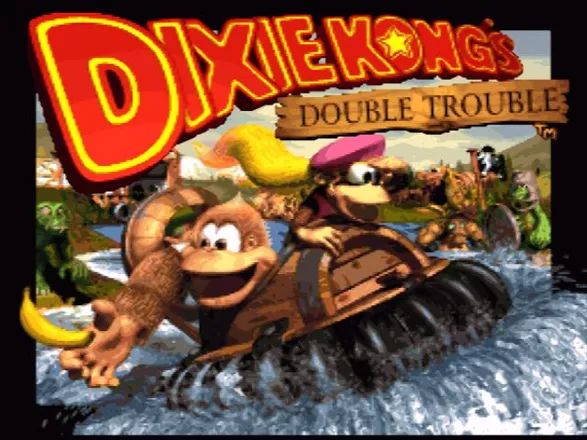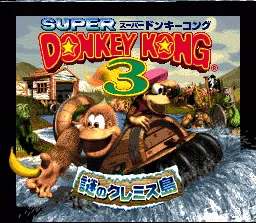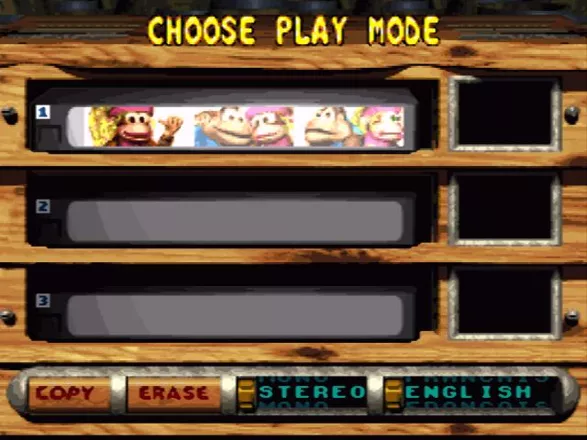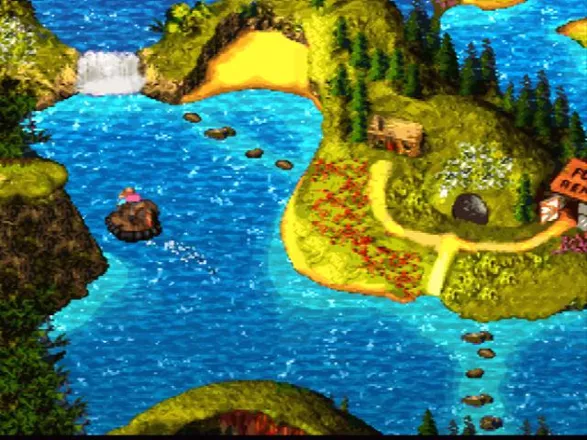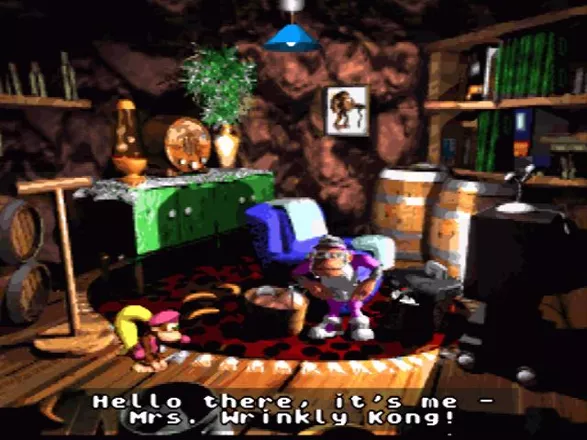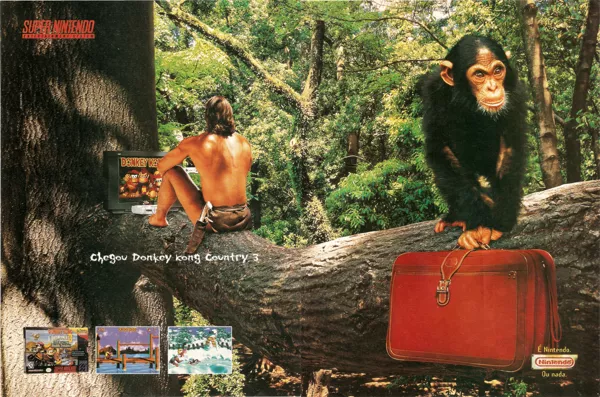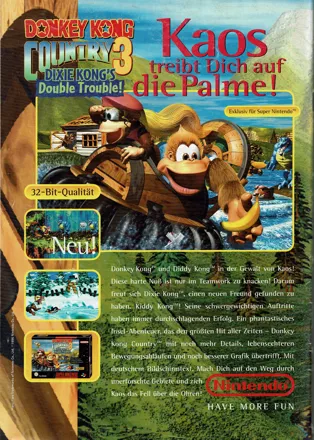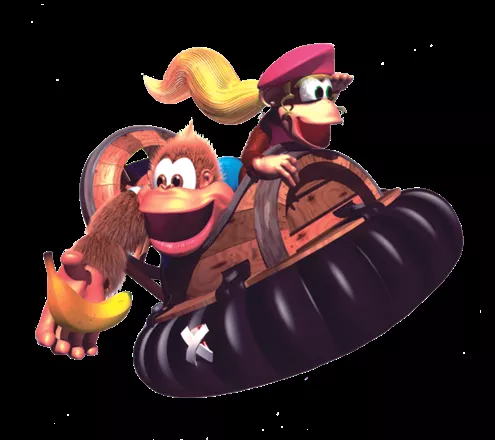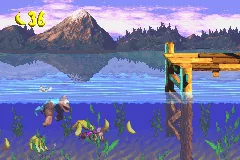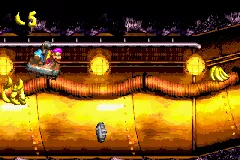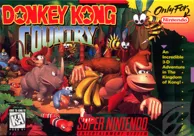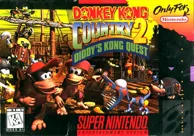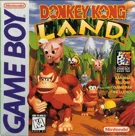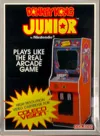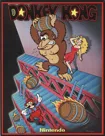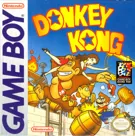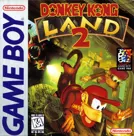Donkey Kong Country 3: Dixie Kong's Double Trouble!
Description official descriptions
This time both Donkey Kong and Diddy Kong have been kong-napped by a mysterious new leader of the Kremlings, and it's up to Dixie and new team mate Kiddy Kong to save the day.
New elements to the series includes the Brother Bears, thirteen Bears who, if you pay them with Bear Coins found in each level, will aid you in your quest by building certain items. Also, new bonus mission have you playing a 1st/3rd person shooter style party game. Plus a host of new enemies, the usual huge end of world bosses and a collection of the Kong family who will help you out as best they can.
The Game Boy Advance version adds a new world Pacifica, which is made up of six stages and a boss level. Also, a new boss called Kroctopuss and a new Brothers Bear named Bachelor has also been added. Swanky's sideshow.got turned into a virtual reality mini-game and Funky Kong also offers his own mini-games to play. Also, five more Banana Birds have been added to the game, increasing the total to 20.
Spellings
- スーパードンキーコング3 謎のクレミス島 - Japanese spelling
Groups +
- Animals: Birds
- Animals: Elephants
- Animals: Fish
- Animals: Primates (monkeys or apes)
- Animals: Spiders
- Console Generation Exclusives: SNES
- Donkey Kong Country series
- Donkey Kong games
- Enhanced ports / Port differences
- Gameplay feature: "Simon says"
- Gameplay feature: Game completion percentage
- Gameplay feature: Multiple endings
- Games with post-credits scene or gameplay
- Genre: Hop and Bop platformer
- Nintendo Player's Choice releases
- Visual technique / style: Parallax scrolling
Screenshots
Promos
Videos
Add Trailer or Gameplay Video +1 point
See any errors or missing info for this game?
You can submit a correction, contribute trivia, add to a game group, add a related site or alternate title.
Credits (SNES version)
73 People (46 developers, 27 thanks) · View all
| Head Programmer | |
| Programmers | |
| Technical Programmer | |
| Head Artist / Characters | |
| Assistant Characters and Animation | |
| Backgrounds | |
| Graphics Manipulation | |
| Additional Graphics Manipulation | |
| Music / Sound Effects | |
| Additional Music | |
| Game Testing | |
| Nintendo Product Testing | |
| [ full credits ] | |
Reviews
Critics
Average score: 81% (based on 46 ratings)
Players
Average score: 4.0 out of 5 (based on 114 ratings with 1 reviews)
The Good
RPG lite features add depth to gameplay.
Graphics an incremental improvement on prequels.
The Bad
Soundtrack doesn't match up to previous games.
Cheap deaths common.
The Bottom Line
After the success of the first two SNES hits, and with the recent launch of the Nintendo 64, Rareware (as they were known at the time) had a difficult job keeping the franchise fresh in the minds of an audience which, in 1995 had a lot to distract themselves with. It was a time of transition in the industry, 3D games were becoming the norm, the first (unsuccessful) attempts at VR were attempting to make waves in the gaming scene and many new manufacturers were entering the ring with their new offerings, most notably Sony.
Rareware themselves were focusing on new 64-bit hardware, and as a flagship studio part-owned by Nintendo, there was pressure on them to get hold of this new technology and create games that could hold up to the high standards set by the likes of the previous Country games, Killer Instinct and Battletoads. There was clearly a priority on the next generation of consoles, as the Nintendo 64 had already been launched in Japan and the United States at the time of this game’s release in November 1996. Because of this, members of the original dev team behind the first two DKC titles, most notably designer Greg Mayles, programmer Chris Sutherland and composer David Wise were not heavily involved in the third title, giving the impression that this third game may not live up to the bar set by the first two entries.
Certainly, if there was a drop in quality with this third game, it could certainly not been seen by it’s graphics. DKC 3 takes the bar set by the Silicon Graphics pre-renderred visuals of the previous games and shifts to a more earthy and vibrant tone. The variety of the stages, which whilst maintaining the same almost stereotypical themes of the previous games; Ice caves, Treetops, Factories all included – have a more chunky and colourful feel to them. North America seems to be the theme here – one stage has you climbing up hollow redwood trees with a giant buzz saw chasing you from the bottom of the screen. It really feels like Rareware managed to squeeze the most out of the limited pallete available on the ageing 16-bit hardware. It’s fair to say they did more than enough to make this game look great in glossy magazine stills – it still ended up selling over 3.5 million copies worldwide on a system that was mostly forgotten about by this point in it’s life-cycle.
The aspect of Donkey Kong Country 3 that is not quite so easy to feel nostalgic about is the level design, especially on some of the later stages. This is a difficult game, and some of the level ideas that may have been great on paper were not necessarily so great in execution. The art to making a platform game difficult – or any type of game game for that matter, is to allow the player to feel that when they fail, they know it was their fault. DKC 3 often falls foul of this principle due to unfair hit boxes on various enemy characters (those bin-lid totting fools on the Koindozer Klamber stage a prime example) and areas where trial and error is the only way to progress. Maybe the large sprites are an issue in this sense compared to the high-resolution, widescreen games that we are now used to, but it’s doubtful anyone could pass Konveyor Rope Klash on their first attempt as they will have no idea of the enemy placement until it’s too late. This is especially frustrating on stages like this (of which there are several) which use forced scrolling, a gameplay device common in 90’s platformers that has thankfully become a relic of that era. Cheap deaths are a theme of the game until you beat it for the first time, the game almost feels more enjoyable on a second or third play-through having memorized some of the more unfair sections.
The overworld in this game deserves a mention as it adds some lite RPG features to the mix which provide a slight distraction from the main game. The main hub world gives the player freedom of movement and it’s possible to find hidden caves and areas whilst exploring here. A lot of this map will require the use of one of several water based vehicles that can be obtained from visiting Funky Kong at his rental shack near the start of the game. The incremental vehicle options become available after taking part in one of several swap quests. These mini side quests are initiated by visiting the Brothers Bear, a dopey set of palette-swapped, bug-eyed bears that reside in wooden huts dotted around the games various world maps. This adds some intrigue into the normal fare of finding bonus rooms and collecting special coins, although there’s not too much in the way of depth to this diversion.
Donkey Kong coins also return from the second game, however earning them is slightly different this time around. You’ll find a Kremlin enemy holding one of them as a shield on nearly every stage in the game, which for the most part easy to find. The difficulty comes in working out how to throw a nearby metal keg so that it bounces of a wall behind the Kremlin while he is facing the opposite way. Again, an interesting diversion to the normal questing and adds a puzzle element to the game progression. Locating all 40 coins in the game reveals the entrance to another secret world should you wish to reach the 105% mark and complete the game outright.
There’s an interesting array of bosses that appear at the end of each of the worlds and are fairly entertaining to tackle and are quite easy after working out the strategy to beating each one. These fights are enjoyable if a little ludicrous and the scale of some of the boss sprites are pretty impressive for a 16-bit title. Belcha (who I’m assuming to be female as her name ends with an ‘a’, an assumption I lazily make based on limited knowledge of latin-based languages) the screen sized barrel springs to mind. The trick is to knock her(?) backwards into a hole by chucking bugs into her gob – pretty trippy but anyone who remembers Crocomire from Super Metroid will no doubt enjoy the similarity. The later bosses offer variety and some degree of challenge, but do not expect to struggle with them too much. The end boss fight also follows a familiar theme to the previous games, K. Rool’s several movement patterns don’t offer too much difficulty once you’ve learned how to dodge them.
The soundtrack is an area of this game that divides opinion amongst fans. David Wise’s tracks for the first two games were memorable for using natural sounds and environmental effects from the stages they were accompanying to really add to the atmosphere of the game. Eveline Fischer’s music for this game doesn’t quite hit the heights of, say, Stickerbrush Symphony but is maybe slightly more high-tempo than the older tracks, which does a job in adding tension to some of the later levels. The music in this game holds up very well and certainly deserves to be better remembered amongst 16-bit enthusiasts.
In the HD era the best way to play this would be via the Wii-U or 3DS store, which are direct ports of the SNES original. A GBA conversion saw release in 2005 which added several mini-games, a new soundtrack and some minor changes to the map, including some extra secrets to find.
Having spent some time with this game a mere 22 years after it’s original release I would say that from a gameplay perspective it holds up well. Apart from some frustrating gimmicks in later levels (damn you Lightning Lookout), the game’s satisfying mechanics and emphasis on exploration adds some depth to the otherwise linear nature of it’s levels. I would still say that the second game stands as the best game of the original trio due to its superior emphasis on snappy platforming action, stellar soundtrack and more nuanced difficulty curve. That said, Donkey Kong Country 3 stands on it’s own two feet against the best platformers of the 16-bit era and, while it may not be the best, it offers enough new ideas to be worth playing today.
SNES · by Adam Domanski · 2023
Trivia
1001 Video Games
The SNES version of Donkey Kong Country 3 appears in the book 1001 Video Games You Must Play Before You Die by General Editor Tony Mott.
Björn Bear
One of bears in the game is named Björn Bear. In Swedish "Björn" means bear and it is common Swedish male name.
Awards
- Electronic Gaming Monthly
- March 1997 (Issue 92) - SNES Game of the Year runner-up + Side-Scrolling Game of the Year runner-up + SNES Game of the Year (Readers' Choice) + Side-Scrolling Game of the Year (Readers' Choice)
Analytics
Related Sites +
-
Nintendo: Donkey Kong Country 3
Nintendo of America's official web site for the GBA version.
Identifiers +
Contribute
Are you familiar with this game? Help document and preserve this entry in video game history! If your contribution is approved, you will earn points and be credited as a contributor.
Contributors to this Entry
Game added by Kartanym.
Wii U, New Nintendo 3DS added by Michael Cassidy. Nintendo Switch added by Rik Hideto. Wii added by Sciere. Game Boy Advance added by gamewarrior.
Additional contributors: Exodia85, Alaka, gamewarrior, pakke, Zaibatsu, Patrick Bregger, FatherJack.
Game added June 6, 2002. Last modified April 19, 2025.



